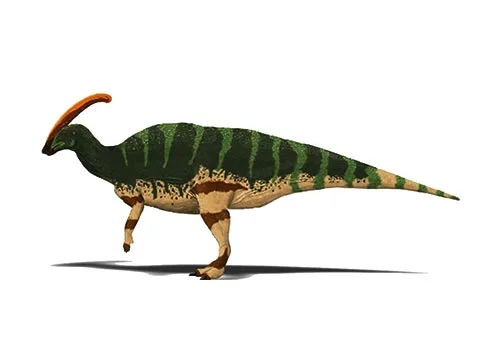Parasaurolophus (Near Saurolophus/Near lizard crest)

Pah-rah-sore-o-loe-fus
William Parks - 1922
Herbivore
Estimated 10 meters long
Euornithopod
P. walkeri (type), P. tubicen, P. cyrtocristatus
Canada - Alberta - Dinosaur Park Formation. USA - New Mexico - Kirtland Formation, possibly also Fruitland Formation, Utah - Kaiparowits Formation
Late Cretaceous, 76-73 million years ago
Parasaurolophus Facts
Parasaurolophus is a genus of herbivorous dinosaur that lived during the Late Cretaceous period, approximately 76 to 73 million years ago. Its fossils have been found in North America, specifically in the western United States and Canada.
The name Parasaurolophus means “near Saurolophus,” referring to its close resemblance to the genus Saurolophus. It is also sometimes translated as “near-lizard crest,” reflecting the fact that the crest on its head was similar to that of other hadrosaurids, or “duck-billed” dinosaurs.
Parasaurolophus is perhaps best known for its distinctive cranial crest, which was an elongated, curved structure on the back of its head. This crest is thought to have been used for communication, as it likely helped amplify the dinosaur’s vocalizations. Scientists believe that Parasaurolophus could produce a wide range of sounds, from low frequency calls to high frequency honks, and that the crest may have allowed them to communicate over long distances.
Parasaurolophus was a large dinosaur, measuring up to 10 meters (33 feet) in length and weighing up to 2.5 tons. Like other hadrosaurids, it was a bipedal/quadrupedal dinosaur that walked on two legs but could also use its forelimbs to support itself when needed. It had a toothless beak at the front of its mouth, and a battery of closely-packed cheek teeth that it used to grind up plant material.
Parasaurolophus is one of the most well-known and studied dinosaurs, thanks in part to the large number of fossils that have been found. Scientists have been able to use these fossils to learn about the dinosaur’s behavior, anatomy, and evolution. Parasaurolophus is a fascinating dinosaur that has captured the imaginations of people of all ages, and it continues to be a popular subject of scientific research and popular culture today.



